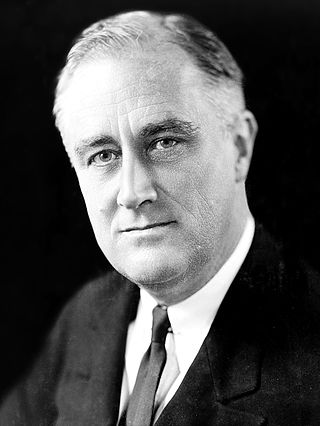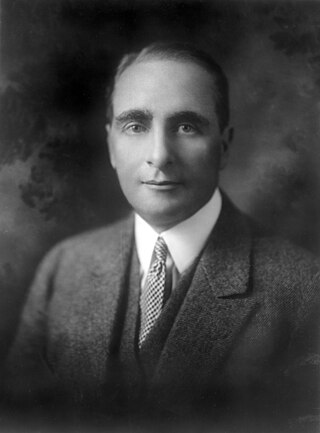
Herbert Clark Hoover was an American politician and humanitarian who served as the 31st president of the United States from 1929 to 1933. He was a member of the Republican Party, and held office during the onset of the Great Depression. A wealthy mining engineer before his presidency, Hoover led the wartime Commission for Relief in Belgium, served as the director of the U.S. Food Administration, and served as the U.S. Secretary of Commerce.

The 1928 United States presidential election was the 36th quadrennial presidential election, held on Tuesday, November 6, 1928. Republican former Secretary of Commerce Herbert Hoover defeated the Democratic nominee, Governor Al Smith of New York. After President Calvin Coolidge declined to seek reelection, Hoover emerged as his party's frontrunner. As Hoover's party opponents failed to unite around a candidate, Hoover received a large majority of the vote at the 1928 Republican National Convention. The strong state of the economy discouraged some Democrats from running, and Smith was nominated on the first ballot of the 1928 Democratic National Convention. Hoover and Smith had been widely known as potential presidential candidates long before the 1928 campaign, and both were generally regarded as outstanding leaders. Both were newcomers to the presidential race and presented in their person and record an appeal of unknown potency to the electorate. Both faced serious discontent within their respective parties' membership, and both lacked the wholehearted support of their parties' organization.

The 1932 United States presidential election was the 37th quadrennial presidential election, held on Tuesday, November 8, 1932. The election took place against the backdrop of the Great Depression. The incumbent Republican President Herbert Hoover was defeated in a landslide by Democrat Franklin D. Roosevelt, the governor of New York and the vice presidential nominee of the 1920 presidential election. Roosevelt was the first Democrat in 80 years to simultaneously win an outright majority of the electoral college and popular vote, a feat last accomplished by Franklin Pierce in 1852, as well as the first Democrat in 56 years to win a majority of the popular vote, which was last achieved by Samuel J. Tilden in 1876. Roosevelt was the last sitting governor to be elected president until Bill Clinton in 1992. Hoover became the first incumbent president to lose an election to another term since William Howard Taft in 1912, and the last to do so until Gerald Ford lost 44 years later. The election marked the effective end of the Fourth Party System, which had been dominated by Republicans. It was the first time since 1916 that a Democrat was elected president.

The United States postmaster general (PMG) is the chief executive officer of the United States Postal Service (USPS). The PMG is responsible for managing and directing the day-to-day operations of the agency.

Charles Curtis was an American attorney and Republican politician from Kansas who served as the 31st vice president of the United States from 1929 to 1933 under Herbert Hoover. He had served as the Senate Majority Leader from 1924 to 1929. A member of the Kaw Nation born in the Kansas Territory, Curtis was the first Native American and first person in a racial minority group to reach either of the highest offices in the federal executive branch.

Alfred Emanuel Smith was an American politician who served four terms as the 42nd governor of New York and was the Democratic Party's presidential nominee in 1928.

Arthur Hendrick Vandenberg Sr. was an American politician who served as a United States senator from Michigan from 1928 to 1951. A member of the Republican Party, he participated in the creation of the United Nations. He is best known for leading the Republican Party from a foreign policy of isolationism to one of internationalism, and supporting the Cold War, the Truman Doctrine, the Marshall Plan, and NATO. He served as president pro tempore of the United States Senate from 1947 to 1949.

Walter Evans Edge was an American diplomat and Republican politician who served as the 36th governor of New Jersey, from 1917 to 1919 and again from 1944 to 1947, during both World War I and World War II. Edge also served as United States Senator representing New Jersey from 1919 to 1929 and as United States Ambassador to France from 1929 to 1933.

Ogden Livingston Mills was an American lawyer, businessman and politician. He served as United States Secretary of the Treasury in President Herbert Hoover's cabinet, during which time Mills pushed for tax increases, spending cuts and other austerity measures that would deepen the economic crisis. A member of the Republican Party, Mills also represented New York in the United States House of Representatives, served as Undersecretary of the Treasury during the administration of President Calvin Coolidge, and was the Republican nominee in the 1926 New York gubernatorial election.

The 1928 Republican National Convention was held at Convention Hall in Kansas City, Missouri, from June 12 to June 15, 1928.

Hoover Field was an early airport serving the city of Washington, D.C. It was constructed as a private airfield in 1925, but opened to public commercial use on July 16, 1926. It was located in Arlington, Virginia, near the intersection of the Highway Bridge and the Mount Vernon Memorial Parkway, where The Pentagon and its northern parking lots now stand.

Harry Nelson Routzohn was an attorney, jurist and member of the United States House of Representatives from Ohio for one term from 1939 to 1941.

Louis Thomas McFadden was a Republican member of the United States House of Representatives from Pennsylvania, serving from 1915 to 1935. A banker by trade, he was the chief sponsor of the 1927 McFadden Act, which rechartered the Federal Reserve System in perpetuity, liberalized branch banking for national banks and increased competition between member and non-member banks. He is known for his antisemitic conspiracy theories, which eventually saw him lose his seat in the House of Representatives.

Herbert Hoover's tenure as the 31st president of the United States began on his inauguration on March 4, 1929, and ended on March 4, 1933. Hoover, a Republican, took office after a landslide victory in the 1928 presidential election over Democrat Al Smith of New York. His presidency ended following his defeat in the 1932 presidential election by Democrat Franklin D. Roosevelt.

Washington Airport was the second major airport to serve the city of Washington, D.C., in the United States. Located in Arlington, Virginia, near the intersection of the Highway Bridge and the Mount Vernon Parkway. The first airport to serve the city was Hoover Field, a private airfield constructed in 1925. Washington Airport, a private airport triple the size of Hoover Field, was built literally across the road in late 1927. The airfield suffered from short and unpaved runways, numerous life-threatening obstructions around the field, poor visibility, and poor drainage. Washington Airport nearly went bankrupt in 1933, and it was auctioned off to a new owner. The new owner also owned Hoover Field, and merged the two into a single airfield, Washington-Hoover Airport.
John Knight was an American lawyer and politician from New York. He was President pro tempore of the New York State Senate from 1925 to 1931, and a United States district judge of the United States District Court for the Western District of New York from 1931 to 1955 and its Chief Judge from 1948 to 1955.

The 1932 United States presidential election in New York took place on November 8, 1932. All contemporary 48 states were part of the 1932 United States presidential election. Voters chose 47 electors to the Electoral College, which selected the president and vice president.

The 1928 United States presidential election in New York took place on November 6, 1928. All contemporary 48 states were part of the 1928 United States presidential election. State voters chose 45 electors to the Electoral College, which selected the president and vice president.

The 1932 United States presidential election in Vermont took place on November 8, 1932, as part of the 1932 United States presidential election which was held throughout all contemporary 48 states. Voters chose three representatives, or electors to the Electoral College, who voted for president and vice president.

The 1928 United States presidential election in Indiana took place on November 6, 1928, as part of the 1928 United States presidential election which was held throughout all contemporary 48 states. Voters chose 15 representatives, or electors to the Electoral College, who voted for president and vice president.

















